
It's not only triple rated, but the Edelrid Swift Protect Pro Dry is also claimed to be more cut resistant than other such ropes on the market, thanks to the addition of Aramid in its sheath. Due to their low weight and bulk triple rated ropes are the bee's knees for use on Alpine terrain, however their low weight comes at a price and they are typically less durable and edge resistant than 10mm single ropes. This is the real advantage of the Swift Protect Pro, as it is both light and edge resistant. Triple rated ropes are also handy on holidays where you're alternating between double and single rope technique (and don't want to bring loads of ropes).
A 60m triple paired with a 60m half would be the perfect setup for road trip around the western US, for instance. These ropes are also much favoured by guides and instructors, and the Swift Protect Pro Dry is particularly appealing for working on mountaineering terrain with two clients on one rope.
This 8.9mm triple-rated rope is certified as a twin, a double and a single rope, making it versatile for use in most situations and climbing disciplines.
I first used it in the slate quarries, shortly after lockdown eased. I wasn't initially keen on the trippy colour scheme, nor the waxy feel of the rope straight out of the packet - something UKC also noticed on a pair of brand new Edelrid half ropes a couple of years ago. It also seemed a shame to waste such a specialised rope on UK crags.
In mid July I headed out to the Alps, deliberately leaving my half ropes at home in favour of the Swift Protect Pro Dry. The first route I climbed with the rope was La Costa, a classic 6a multi pitch in Arve Valley (which I can't recommend highly enough, especially if you enjoy wiggy jamming). We rapped in on the Swift Protect Pro dry, tied to an Edelrid Rapline. We then coiled the tag line and used the Swift Protect Pro Dry as a single to climb out. The Aramid in the sheath makes the rope feel harder and stiffer than other triple rated ropes I have used. I have found some skinny singles less than inspiring, especially those with a low sheath proportion that fluff quickly, but knowing about the edge resistance of the Swift Protect Pro Dry is reassuring when there are sharp edges around. And luckily, after a few abseils and pitches of climbing, the rope started to lose its initial waxy feel.
The next route I used the rope on (again paired with a tagline) was the Ratti Vitali on the West Face of the Aiguille Noire. This route requires the use of virtually every rope technique under the sun. On the approach you have to scramble up to a col, before making a couple of abseils onto the complex Freney Glacier, which then has to be navigated. The route is a mix of pitching and moving together, include a pitch of aid climbing. Then there is the descent, down the never ending East Ridge, which involves a lot of moving together and quite a few short abseils. Lastly, towards the bottom of the descent, light faded, and we spent a few hours laid on the rope, which was surprisingly comfortable. After this ordeal the rope, though looking slightly fluffy (and thankfully much less trippy), was still in good shape. This is pretty impressive: in my experience thin single ropes and long granite routes don't mix well. Had it been a normal rope of similar diameter I would have expected it to have been looking the worse for wear after that, but not in this case.
My next route with the Swift Protect Pro Dry was the traverse of the Aiguille du Peigne, Pelerins and Deux Aigle - another beast with lots of pitching, moving together, up climbing, down climbing and rappelling, and with a some pretty disgusting choss thrown in for good measure. To top this off the day finishes by reversing the Midi-Plan traverse, which was in kitty-litter condition, and we spent a beautiful night sleeping on the rope in the Aiguille Du Midi's toilets.
After nearly 2000m of abuse I was expecting the rope to be in something of a state. But whilst it is lightly fluffed in places the sheath is still going strong and I don't think it'll be wearing out anytime soon. Perhaps that Aramid is doing its job!

What is a Triple Rated Rope?
A triple rated rope is a thin single rope - normally between 8.7mm and 9.2mm in diameter - that also passes the half and twin rope tests, according to EN 892. I'm an Aspirant Guide, and use triple rated ropes a lot when guiding and instructing, be that on multi pitch climbs in North Wales or longer alpine mountaineering objectives.
I also use ropes like this for my own climbing, particularly on longer alpine routes. I will also often pair a triple rated rope with an 8.5mm half rope if I am going for a mixed trad/sport day - say, climbing in the Dinorwic Slate Quarries or on Upper Pen Trwyn, where one route might be a zig-zagging trad line, suited to double rope technique, and the next a straight up sport route where a single rope would be preferable.
In my experience Triple-rated ropes are not the most durable of things. To create a thin enough rope, manufactures often seem to reduce the thickness of the rope's sheath. With this in mind I am often quite nervous when using one as a single when there are sharp edges around. I've used, and destroyed, lots of different triple rated ropes over the last few years, from Petzl, Edelrid, Simond, Mammut, Beal and Sterling.
Construction
These days ropes don't snap in normal falling situations, unless you put them near an edge (or contaminate them with chemicals). Loading a rope over a sharp edge is the biggest single cause of rope failure, and the risk of this happening clearly increases if you increase the load - for example mountaineering as a team of three.
This is where the Edelrid Swift Protect Pro Dry comes in. As we've said, it has Aramid blended into its sheath to increase cut resistance. Whilst it is highly cut resistant Aramid is a totally static fibre, which makes it less than ideal for use in dynamic climbing ropes. However the designers at Edelrid have been able to integrate it with polyamide to create a rope that is both cut resistant and dynamic enough to pass the single rope test.
Edelrid have created their own edge test, which took five years to develop, and gives consistent results - unlike previous edges tests. In Edelrid's test the rope is tensioned at a given weight over a cutting wheel, which is cleaned after each turn. The length of the wheel's revolution is then measured, giving you a value for the cut resistance of the rope.
Philippe Westenberger, Head of Product at Edelrid, explained the test to UKC at the ISPO 2019 trade show:
And here he is again in an Edelrid video explaining a bit more of the background to edge tests, and the merits of Edelrid's testing system:
In testing Edelrid have found the Swift Protect Pro Dry be far harder to cut than both a standard Edelrid Swift and an Edelrid 10mm rope. With an 80kg load applied the Swift Protect Pro Dry cut after 100cm, whilst the 10mm rope cut at 66cm, and the standard Swift cut at 54cm.
Dry treatment
The Edelrid Swift Protect Pro Dry passes the UIAA water repellent test. This means that it absorbs virtually no water (1-2% according to the test) and is resistant to freezing. Whilst I am yet to use the rope for winter climbing it has got a fair old soaking on soggy glaciers, and as far as I could tell absorbed minimal water.
Packaging, handling and knotability
All Edelrid ropes are sent packaged using Edelrid's 3D coiling. This allows the rope to be pulled straight out of the packet and used - a pain free solution, rather than painstakingly faffing around unlooping, which if you get it wrong can quickly turn a brand new rope into a tangled mess. All you need to do is pull it through the hole as instructed, resulting in a happy, kink-free uncoiling experience. I didn't take a photo of this process, but there is one in Rob's review of the Edelrid Swift Eco:
When brand new I wasn't that impressed with the handling of the Swift Protect Pro Dry. It felt quite cable-like, and - as I've mentioned - also felt a little sticky in the hand. It still paid out well, and I suspect I'm making something out of nothing, or just noticing that it was different. Thankfully, with use the rope has softened and the sticky texture has disappeared. It now feels like any other rope. The sheath also fluffed up quicker than other ropes I have used, however I think this is how the Aramid in the sheath responds to abrasions, and I don't think this has any affect on the long term durability. The Swift Protect Pro Dry feels quite hard, and holds its shape well. By that I mean it isn't particularly soft, and the rope still feels cylindrical, even when loaded over a karabiner. This is particularly helpful if you do a lots of short roping as it makes the rope easy to hold in your hand - or at least it feels grippy to me.
Although it is a little stiff, in use I have found the rope to knot well. That said all knots should always be well dressed and tightened, and those tied with this rope are no exception!
Bluesign
Edelrid, along with Mammut, are the only climbing rope manufacturers to be granted Bluesign status. Bluesign is an internationally recognised standard for sustainable and responsible textile manufacture. Basically the production of Edelrid ropes uses less water, less CO2, less energy, and fewer chemicals, than conventional rope production.
Weight
The Edelrid Swift Protect Pro Dry weighs 53g per metre, only one gram per metre heavier than the standard Swift. I'd call that a modest increase in weight for a considerable increase in safety.
Lengths and prices
Edelrid sell the rope the following lengths. I looked at the prices of a 60m dry treated rope from other leading rope manufactures to compare. Edelrid's Swift Pro Dry is £180, Beal's Joker Golden Dry is £184, and Petzl's Volta Guide is £209. With this in mind, and considering the substantial increase in safety afforded by the Swift Protect, I think it is well worth spending the extra £20 on the Swift Protect Pro Dry over the Swift Pro Dry.
- 30m £150
- 40m £165
- 50m £180
- 60m £200
- 70m £220
- 200m £600
Summary
After an uncertain start I have been very impressed with the Edelrid Swift Protect Pro Dry. Its increased cut resistance increases my safety margin when mountaineering with two clients, for only a nominal weight gain. This together with it being easy to hold in the hand makes it my go to rope for mountaineering. I think the rope will be of particular interest to guides and instructors, but this would also be my rope of choice when climbing with friends on gnarly alpine routes. When it wears out I will definitely be purchasing another to replace it.
- With thanks to Edelrid's Philippe Westenberger for the technical input
Edelrid say:
The first dynamic single rope with a sheath that includes aramid, for markedly increased cut resistance. Thanks to a special processing method, the Swift Protect Pro Dry remains dynamic. Despite reinforcement with aramid and the overall higher sheath content, the impact force remains within the required standard. These characteristics make the Swift Protect Pro Dry the ideal lead climbing rope and the perfect companion for alpine climbing and mountaineering.
For more informatin see edelrid.de

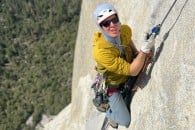




















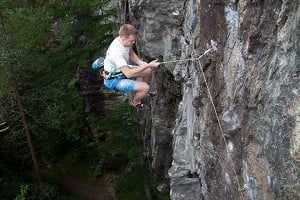
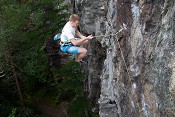
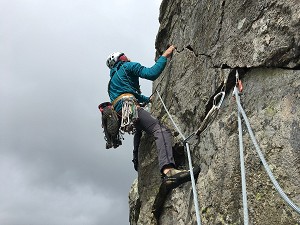
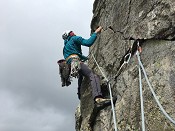
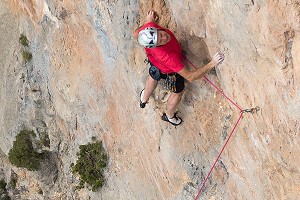
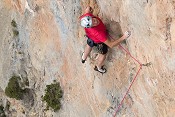




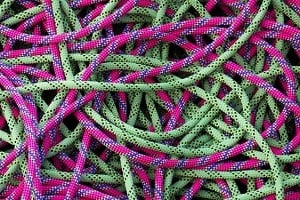

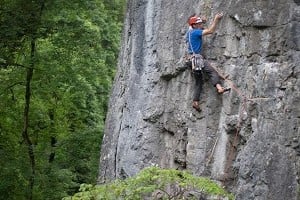

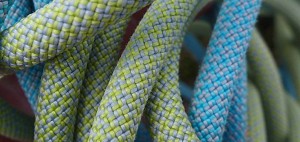

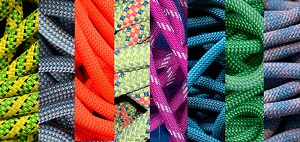

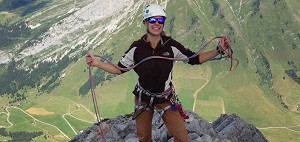

Comments